3 ways to enable SATA AHCI mode in BIOS on Windows
By Livia | 23/Nov/2024
SATA hard drive is workable in IDE or AHCI mode. Compared to AHCI(the abbreviation of Advanced Host Controller Interface mode) and IDE moed, the former is better due to it gives better read and write times and more extensive design support than the older IDE does. Taking AHCI mode can also improve bandwidth speed in performance solid-state drives. It means that if you choose AHCI mode, all the SATA features can be available.
In order to enable SATA AHCI mode, we will take Windows 10 for example. This article will provides you 3 ways of how to enable SATA AHCI mode in BIOS on Windows 10.
Method 1: Enable SATA AHCI Mode through Deleting SatrtOverride
1. Press Win + R to launch Run on Windows 10. Type regedit into the box and press the Enter.
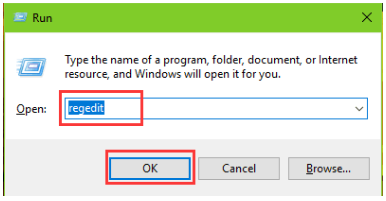
2. When the Registry Editor window pops up, navigate to the below location and then delete the file StartOverride.
HKEY_LOCAL_MACHINE\SYSTEM\CurrentControlSet\Services\storahci

3. Open the Notepad and paste the below text into the box. Save the document as AHCI.bat.
reg delete "HKEY_LOCAL_MACHINE\SYSTEM\CurrentControlSet\Services\storahci\" /v StartOverride /f

4. Right click on the file you`ve just saved and select Run as administrator.
5. Type Yes into the pop-up Command Prompt window and hit the Enter.
Now you can restart the computer and enter the BIOS to enable the SATA AHCI mode. Here we will take Phoenix BIOS for an example, follow the route below to enable the SATA AHCI mode in Phoenix BIOS.
1. Use the Right Arrow key to choose the Main tab.
2. Use the Down Arrow key to highlight SATA Mode entry and press the Enter.
3. Use the Down Arrow key to select AHCI Mode and press the Enter.
4. Press F10 to save the changes and exit the BIOS.
Method 2: Enable AHCI Mode via Registry Modification
1. Launch the Run and type into regedit, and then hit the Enter.
2. When the Registry Editor window pops up, navigate to the following location
HKEY_LOCAL_MACHINE\SYSTEM\CurrentControlSet\Services\iaStorV
3. Highlight the file iaStorV and double click on the Name Start in the right column. Modify the value as 0 and click on OK.

4. Expand the iaStorV file and highlight the file StartOverride. Double click on the Name 0 in the right column and set the value to 0.
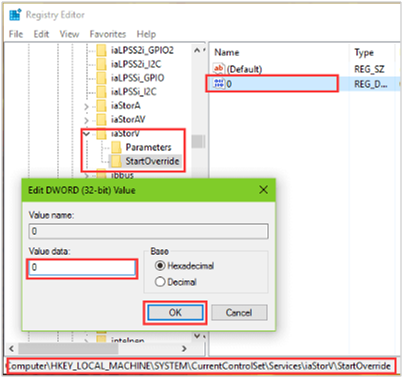
5. Now navigate to the follow location and repeat the same value settings as step 3 and 4. (storahci-Name Start-value 0, storahci-StartOverride-Name 0-value-0)
HKEY_LOCAL_MACHINE\SYSTEM\CurrentControlSet\Services\storahci
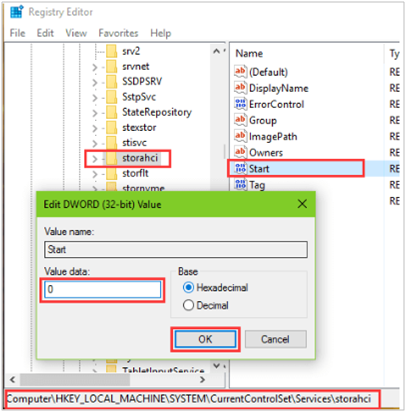
HKEY_LOCAL_MACHINE\SYSTEM\CurrentControlSet\Services\storahci\StartOverride
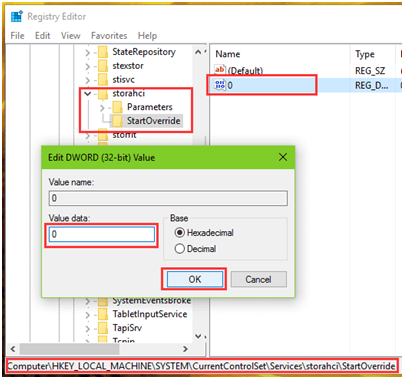
Remember after the value modification, you need to restart the computer and enter the BIOS to enable AHCI mode as the same steps as in Method 1.
Method 3: Enable AHCI Mode via Command Prompt
If you want to install Windows OS on a Solid State Drive and boot it successfully after enabling AHCI in the bios, you can also follow the steps below to enable AHCI mode.
1. Right click on the Start menu and select the Command Prompt (Admin).
2. Type bcdedit /set {current} safeboot minimal into the dialog box and press the Enter.
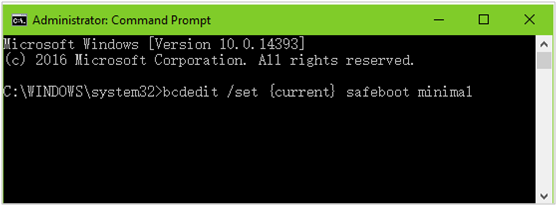
3. Close the window and restart the computer to enter the BIOS.
4. Enable SATA AHCI mode in BIOS with the same steps as in Method 1, and then exit to boot into Windows safe mode automatically.
5. In the safe mode, open the Command Prompt (Admin) and type into bcdedit /deletevalue {current} safeboot, and then hit the Enter.
